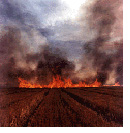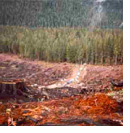 Resource Dilemma #1: The Burn Resource Dilemma #1: The Burn
U.S. farmers are forced to burn or otherwise handle approximately 250 million tons of agricultural residues annually. The burning of crop residues releases substantial particulates and emissions, which pollute the air, contribute to global warming and create serious health and safety risks for farmers, their families and surrounding communities. The massive burning of agricultural resources also presents a substantial missed opportunity for sustainable resource management and rural economic development.
|
Photo: Wheat Stubble Burning
Courtesy of Larry Schwarm
Also check the very informative NASA site on biomass burning.
|
 |
 Resource Dilemma #2: The Clearcut Resource Dilemma #2: The Clearcut
Consistent overlogging has had devastating impacts, leaving less than 5% of the nation's virgin forests standing. Despite projected shortages, wood fiber continues to be the number one raw ingredient for the paper and building materials sectors. Domestic consumption alone of wood fibers is presently almost 200 million tons, and is expanding by about 4 million tons per year. The pulp and paper industry continues to rely on virgin wood for almost 70% of its total fiber supply, while non-wood fibers represent less than 1% of total feedstock inputs.
|
Photo: Looking Down on a Logged Hill
Randy Stoltmann Wilderness Area
Global Research Network on Sustainable Development-Forests and Forestry
|
 |
The Future...
Using readily available agricultural by-products for industrial production represents an environmentally-sound, technically feasible and economically beneficial solution to the looming wood fiber shortage and the resource waste of agricultural burning.
Fiber Futures is working to convert troublesome agricultural residues and other non-wood fiber crops into paper, building materials, textiles and other fiber-based products.
|



